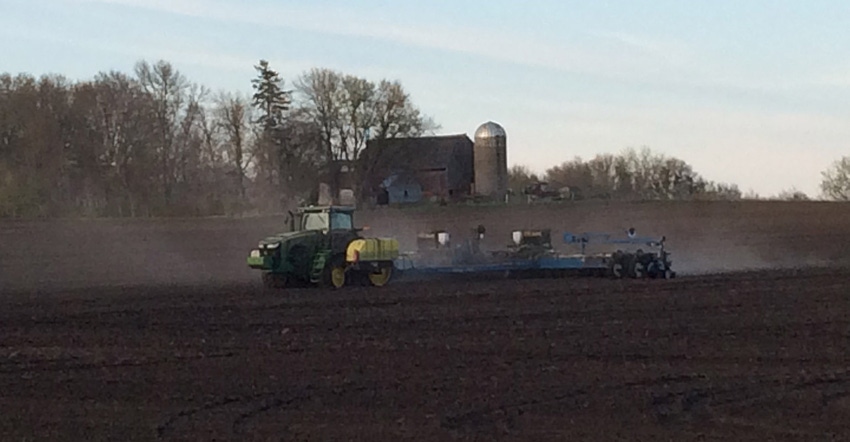
Marc Padrutt was looking at his wet fields and forecasts for more rain when he decided it was time to make a switch last week.
“I had planned to plant corn in the 112- to 120-day range, but I’ve now switched several hybrids to 108-to 114-day range,” says the Decatur, IL farmer. “We are behind, so the reality is, the bulk of our acres won’t go in here until the end of May.
“I remember 2009 we had that late harvest, and that’s not fun to dry corn when it’s early November,” he recalls. “With the decline in commodity prices I want to dry as little as possible.”
Beating the frost
Mike Kavanaugh, agronomy manager at AgriGold, says the decision to switch hybrid maturities boils down to two things: yield risk and beating a killing frost. And it’s no secret that good yields have kept many farmers profitable despite high costs and low prices.
“We’ve trended toward fuller season hybrids over the last 3 to 5 years because that’s where the most yield is,” he says. “The fuller the season in every geography, the most yield we’re getting, so we hate to see people switch out of those fuller season hybrids and yield is the biggest factor.”
Some university charts claim yield loss takes place after specific dates, but Kavanaugh says some of that information may be outdated, since biotech traits now protect those bushels. “That’s not really reflected in those university charts,” he says. The latest genetics handle stress and drought much better than 10 years ago.
“One thing you don’t want to do is switch to an early season hybrid that has never been tested in your area,” he cautions. “Sometimes they try something that’s not adapted to their geography and they get a disease they didn’t even think about.”
Before switching to an early season hybrid make sure you understand the Growing Degree Units needed for the corn you plant, from planting date to black layer.
According to Purdue University research, longer-season hybrids can ‘catch up’ when planted later than optimal date, and still mature before a killing frost, although no one can make any guarantees.
“Purdue studies show that, when planting after May 1, it takes 6.8 GDUs less per day to reach black layer,” Kavanaugh explains.
So, say you plant a hybrid on May 1 that requires 2,800 GDUS from planting to black layer; that same hybrid planted May 15 might require 2,698 GDUs from planting to black layer. Likewise if you plant that hybrid May 30 it would take 2,596 GDUS from planting to black layer. If you planted June 15 it might take 2,494 GDUs.
“You can’t guarantee this, but that’s what university data has shown,” says Kavanaugh.
Steve Gauck, field agronomist at Beck’s Hybrids, agrees.
“After we get past May, the reproductive ability of corn will adjust the later we plant,�” he says. “It takes 6 to 7 GDDs less for each day after May 1 that we plant, so with a 110-day corn that gets planted May 31 it acts like a 101-day hybrid,” he says. Don’t be switching hybrids just yet – the yield risk is a concern. We need bushels to yield through these prices.”
Even so, “as we get later in May it gets more difficult for growers who don’t have drying capacity, who sell off the combine,” Gauck adds. “There’s not a lot of moisture difference between early and late hybrids but when we start getting to the third or fourth week in May it’s hard to convince people not to be making those switches.”
Seed industry inventory
And, it’s not clear if the seed industry could manage a massive hybrid switch. Because of the value of inventories over the last 5 to 10 years, the seed industry has had to manage more tightly than before the era of traits and treatments, says John Kermicle, AgriGold’s general manager.
“I do think it would be a challenge for the industry to have a massive switch to where you’re taking maturities out of zones,” he says. “It’s not like there are warehouses of corn sitting around waiting for something like this to happen.”
Even so, “We are fortunate to have a large portfolio of products which allows our team to work closely with growers to navigate challenges and help them reach their goals,” he adds.
But unless the skies clear and millions of acres of seed go into the ground over the next 10 days, more worried farmers will be calling their seed dealers.
“The seed companies are saying don’t throw away these perfectly good hybrids,” says Padrutt. “Yes, they will black layer in October, but the reality farmers face is the drying costs.
“The reality is, it’s going to be late planting and we don’t want to complicate harvest if we can avoid it,” he concludes. “That’s what farmers are looking at.”
About the Author(s)
You May Also Like






